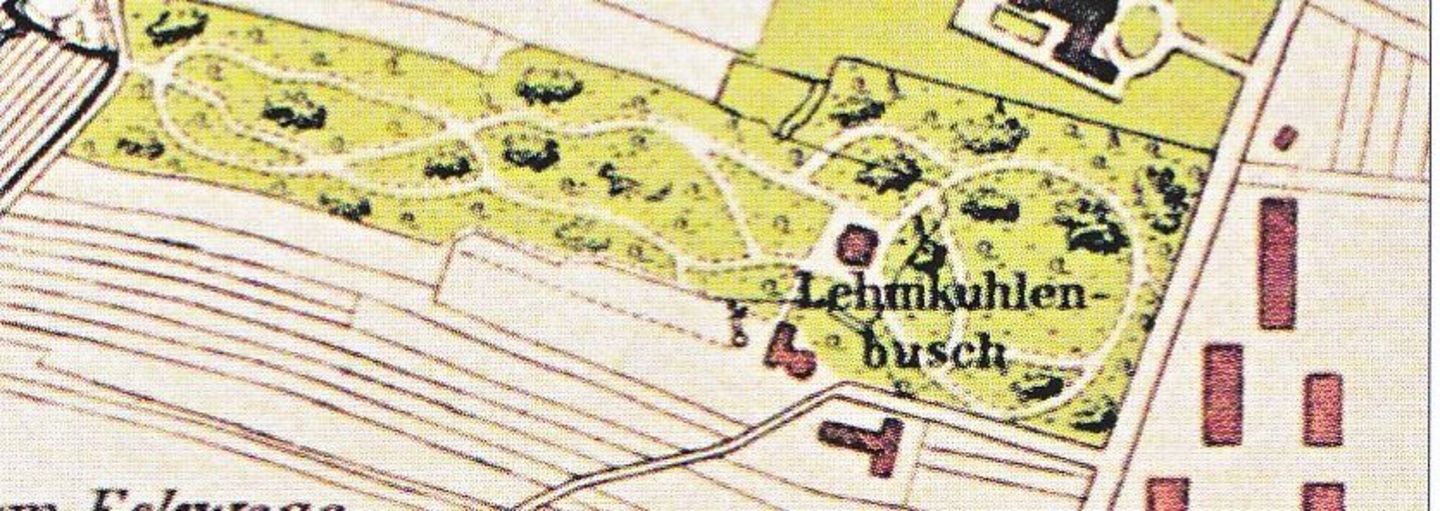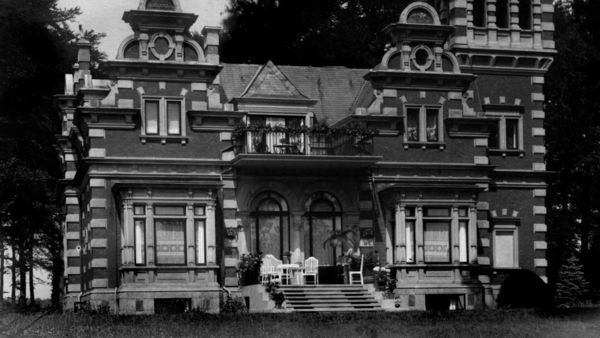Originally, clay had been extracted at the site of today's Hanse-Wissenschaftskolleg. The name "Lehmkuhlenbusch" probably goes back to the hollows that were created in the process. The clay was used extensively in house construction.
In 1872, the Bremen-based merchant Johann Abraham Albers (1830-1886) acquired vast tracts of land here. The area was also called "Delmenhorst's Switzerland". Albers had the large property converted into a park. To this day, it is uncertain whether the garden architect Franz Wilhelm Benque, creator of the Bremen Bürgerpark and the Wollepark (garden of the Lahusen family) in Delmenhorst, was involved in the design. Albers built a Neo-Renaissance style villa in this park in 1880; a typical example of upper middle-class architecture.
Founding History of the Hanse-Wissenschaftskolleg
1991/92
First plans to establish an Institute for Advanced Study in the northwest region of Germany.
February 27, 1991
At a joint meeting of the cabinets of the states of Bremen and Lower Saxony, a decision is made to expand practical cooperation between the universities of Bremen and Oldenburg.
July 3, 1991
At a symposium on "Science and the Region" organized by the heads of government of the states of Bremen and Lower Saxony, the science departments are commissioned to present a concept, ready for decision, for a Bremen-Oldenburg Science Center as a central building block of cooperation between the two universities. The representatives of companies, chambers of commerce, trade unions, scientists, and politicians present at the symposium unanimously endorse the idea.
May 12, 1992
In their joint cabinet meeting, the state governments of Bremen and Lower Saxony decide to establish the Hanse-Wissenschaftskolleg. In the following period, the first plans are initiated.
August 24, 1993
The joint cabinet committee of the states of Lower Saxony and Bremen decides the following:
"Establishment of a Hanseatic Science Center [later: Hanse-Wissenschaftskolleg]. The state governments of Bremen and Lower Saxony take note of the status of implementation of the resolutions of the Joint Cabinet Meeting Bremen/Lower Saxony of May 12, 1992 on the establishment of a Hanseatic Science Center and instruct the Ministry of Science and Culture (in charge) and the Senator for Education and Knowledge to further advance the planning on this basis. In particular, the draft of a foundation charter (including statutes) for the establishment of a Hanseatic Science Center Foundation is to be prepared and submitted to the cabinets together with a cost and financing plan coordinated with the finance departments of the two states. The foundation is to be endowed with a share capital.
The state governments of Bremen and Lower Saxony agree to the location of the Hanseatic Science Center in Delmenhorst on the condition that the city of Delmenhorst provides the necessary land of approximately 16,700 m2 free of charge, adequately prepares the access road, and finances at least DM 3 million of the construction investment costs.
The state governments of Bremen and Lower Saxony agree that of the remaining construction investment costs of DM 5 million, Bremen shall bear DM 2 million and Lower Saxony DM 3 million."
August 1993 to March 1995
The statutes, foundation deed, and a first, rough financing plan for the Hanse-Wissenschaftskolleg are worked out by the planning group "Hanse-Wissenschaftskolleg".
May 1994
Prof. Dr. Thomas Blanke and Prof. Dr. Ulrich K. Preuß, founding representatives of the Universities of Oldenburg and Bremen, present their "Recommendations for the Establishment of a Hanse-Wissenschaftskolleg in Delmenhorst", which was developed in cooperation with the planning group "Hanse-Wissenschaftskolleg". The recommendations present the new institution conceptually and in its embedding in the regional and supra-regional scientific landscape.
February 8, 1995
The Senate Commission of the Bremen Parliament for the Special Investment Program decides to finance the Hanse-Wissenschaftskolleg making use of funds of the Special Investment Program.
14 . February 1995
The Deputation for Science of the Bremen Parliament unanimously decides to establish the Hanse-Wissenschaftskolleg Foundation and to finance it using funds of the Special Investment Program.
March 7, 1995
The memorandum by Professors Thomas Blanke and Ulrich K. Preuß is submitted by the Senate to the Bremen Parliament as an annex to printed matter 13/1178. At the same time, the Senate asks the Bürgerschaft to approve the establishment of the foundation under private law "Hanse-Wissenschaftskolleg". The printed matter states, among other things:
"The history of science in the region is still very young and the two universities [Oldenburg and Bremen] are young universities. Only a few disciplines have already developed a recognizable profile and are perceived in the international scientific landscape in the way that would be desirable. The institution Hanse-Wissenschaftskolleg will play an important role in this context by facilitating this profile building, by ensuring a stronger integration of the regional scientific institutions into the international scientific community and therefore by improving the image of regional science. Because of the uniqueness of this institution in northwestern Germany, special attention will be paid to the universities associated with it. Impulses arise for top-level research through improved contacts and more intensive exchange with foreign scientists."
From April 1995
A search committee for the rector of the future Hanse-Wissenschaftskolleg is established. It is composed of: Prof, Dr Michael Daxner, President of the University of Oldenburg; Prof. Dr Wolfgang Frühwald, President of the German Research Foundation; Bringfriede Kahrs, Bremen Senator for Education, Science, Art and Sport; Prof. Dr Wolf Lepenies, Rector of the Wissenschaftskolleg zu Berlin; Prof. Dr Gerhard Neuweiler, Zoological Institute of the University of Munich; Dr. Henning Scherf, President of the Senate of the Free Hanseatic City of Bremen; Helga Schuchardt, Lower Saxony Minister for Science and Culture; Prof. Dr. Jürgen Timm, Rector of the University of Bremen; Prof. Hank L. Wesseling, Netherlands Institute for Advanced Study in the Humanities and Social Sciences, Wassemar (Netherlands).
October 5, 1995
The foundation charter of the Hanse-Wissenschaftskolleg is issued in Bremen. Bringfriede Kahrs, Senator for Education, Science, Art and Sport, signs for the Free Hanseatic City of Bremen; Helga Schuchardt, Minister for Science and Culture, signs for the State of Lower Saxony; Jürgen Thölke, Lord Mayor of Delmenhorst, and Dr. Norbert Boese, First City Director of Delmenhorst.
August 28, 1996
Science Minister Helga Schuchardt (Lower Saxony) and Science Senator Bringfriede Kahrs (Bremen) make Prof. Dr. Dr. Gerhard Roth, neurobiologist at the University of Bremen and spokesman of the special research area "Neurocognition" of the Universities of Bremen and Oldenburg, the offer to become founding director of the Hanse-Wissenschaftskolleg.
October 9, 1996
At the invitation of Minister Schuchardt and Senator Kahrs, a press conference is held in the town hall of Delmenhorst. There, the recently appointed founding rector Prof. Roth presents the concept of the Hanse-Wissenschaftskolleg.
November 8, 1996
In Delmenhorst's town hall, Bremen-based architect Prof. Manfred Schomers presents his model for the new institute building. It comprises three elements: (1) the 60-meter-long, three-story residential wing with 21 apartments for the fellows, laid out in an east-west direction and open to the south; (2) the communication zone with offices, library, reception, bistro, and a lecture and conference room that can be divided into three rooms; (3) the intervening two- to three-story hall.
February 4, 1997
In the Delmenhorst town hall, the foundation board of the Hanse-Wissenschaftskolleg meets for the first time in its full composition. Present are: Science Minister Helga Schuchardt (Lower Saxony; chair); Science Senator Bringfriede Kahrs (Bremen); First City Director Dr. Norbert Boese (Delmenhorst); Lord Mayor Jürgen Thölke (Delmenhorst); Prof. Jan Borgman; Oldenburg University President Prof. Michael Daxner; Bremen University Rector Prof. Jürgen Timm, and Founding Rector Prof. Gerhard Roth. With a view to the strengths of the universities of Bremen and Oldenburg, three focal points of the research program are defined: neuroscience and cognitive research, marine research, and social sciences/social policy.
April 1997
Dr. Thomas Metzinger starts work as the first fellow of the Hanse-Wissenschaftskolleg. By the end of 1997, seven more fellows from several countries join, five neuroscientists and cognitive scientists, and two social scientists.
August 20, 1997
In the presence of representatives of the city of Delmenhorst, the founding rector and numerous guests, Lower Saxony's Minister of Science, Helga Schuchardt, and Bremen's mayor, Dr. Henning Scherf, jointly lay the cornerstone for the new building of the college at Lehmkuhlenbusch in Delmenhorst. Scherf calls the building a "place for ambitious scientific work" by "pioneers of the future."
September 19-21, 1997
First conference of the Hanse-Wissenschaftskolleg at the University of Bremen with 30 participants. The topic is "Animal Mind".
October 13, 1997
Opening ceremony of the Hanse-Wissenschaftskolleg in Delmenhorst. The musical program including "Infra. Music for Eleven Instruments" by the Italian composer Luca Lombardi has its world premiere. The keynote speech is given by Prof. Dr. Wolfgang Frühwald, President of the German Research Foundation.
October 1997
The staff of the Hanse-Wissenschaftskolleg moves into temporary offices in Delmenhorst's Fischstraße.
November 7, 1997
In the presence of Lower Saxony's Minister of Science Helga Schuchardt and Bremen's Senator for Science Bringfriede Kahrs, the topping-out ceremony is held at the construction site of the college building.
Laying of the foundation stone for the new college building at Lehmkuhlenbusch in Delmenhorst on August 20, 1997. From left: Delmenhorst's First City Director Dr. Norbert Boese; Harald Groth, Member of the Lower Saxony State Parliament; State Councilor Dr. Hans-Henning Zietz (Bremen); Lower Saxony's Minister of Science Helga Schuchardt, and Founding Director Prof. Gerhard Roth.
January 15, 1998
Delmenhorst Mayor Jürgen Thölke hosts a reception for the first nine fellows of the Hanse-Wissenschaftskolleg at the city's town hall.
June 19-11, 1998
The first major international conference of the Hanse-Wissenschaftskolleg with 320 participants from all over the world on the topic "Neural Correlates of Consciousness" takes place in Bremen. Scientific organizer is the fellow Thomas Metzinger.
July 23, 1998
With the participation of numerous invited guests and citizens of Delmenhorst, the ceremonial handing over of the keys to the new building at Lehmkuhlenbusch 4 to the founding rector Prof. Gerhard Roth takes place. Bringfriede Kahrs, Bremen's Senator for Education, Science, Art and Sport, Thomas Oppermann, Lower Saxony's Minister for Science and Art, and Jürgen Thölke, Lord Mayor of the City of Delmenhorst, speak words of greeting, and Rector Roth gives a speech.




